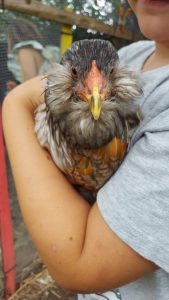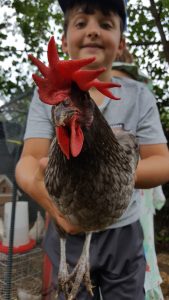Yes, it’s been a weird year, but a lot of great books for young people were still published, and the American Library Association just gave out its annual awards to the best of them. We have compiled full lists of all the winners and honorees in print, as well as ebook and digital audio formats. For the past couple of years, I’ve been giving out my own little awards for books whose uniqueness makes them wonderful, but also not quite what the major award committees are looking for, called Elpys (inspired by the sound of “LPL”), even though that sounds more like something you would see at a French bakery or bounding across a meadow, and there’s no gold or silver medal sticker that goes on the winners’ covers.
This year will be no different, except for one thing. For the past two years I've been thrilled to crown a winner in the "Best Book about a Chicken Circumnavigating the Globe" category, but sadly, no qualifiers were published this year. However, a new category comes close, so we’ll kick it off with that.
Best Book Featuring Chickens from around the Globe
Sounds All Around: A Guide to Onomatopoeias around the World, by Dr. James Chapman
Back in French class, I always loved the fact that baby chicks in France said “piou piou” instead of “cheep cheep.” Turns out, so did author/illustrator James Chapman, who studies and draws onomatopoeias from around the world, because, as he puts it on his web site Soundimals, “they're all just interpretations of the same sound, shaped by the culture and language of each place.” Sounds all Around is Chapman's collection of how people write the same sound differently in various languages, from the sounds of chickens and other animals (in Belarusian, turkeys go “kuldy buldy!” instead of “gobble gobble!”), to sword fights (swords in Russian make a “dzyn!” sound), to people eating (a German chowing down sounds like “mampf mampf”), or exclaiming amazement (Hungarian is my favorite: “huha!”). Chapman’s cartoony illustrations add to the charm of this one, and I can’t wait for his next book, due out in September, which collects and illustrates proverbs from around the world. His work is funny, but also instructive, for, as he puts it, it reveals that “across the world, there are dozens of ways to pretend to be a dog. But they are all equally beautiful. We live in a planet filled with diversity and countless ways to describe our surroundings. There are no right or wrong answers when it comes to sounds, just different perspectives.”
Kot kot kotkodacs! Kot kot. Kotkodacs!
Oh yeah, from now on, I’ll be having chickens from various countries introduce the other categories in their own languages. Kind of like the Oscars, but more like the Douglas County Fair. That was Hungarian clucking for:
Best Book Featuring Characters with Heads Made of Fruits and Vegetables
Crabapple Trouble, by Kaeti Vandorn
Speaking of the county fair, this strange and sweet offering from first-time graphic novelist Vandorn is just the thing if you like comics with a positive message for the early chapter book crowd, or if you’re simply a fan of anthropomorphized produce. Each character’s head is drawn as a different fruit or vegetable, with an effect reminiscent of Marc Brown’s Arthur stories about animal-headed kids, since the characters seem quite human otherwise. So human, in fact, that the book is one of the best I’ve seen to take on anxiety and comparison culture, a useful preparatory text for kids growing up in the world of social media.
Gaggala gu! Gaggala gu! Gaggala gu!
Translation from Icelandic:
Best Book for a Year We All Needed to Be Brave (and Really Missed Our Grandparents)
Nana Akua Goes to School, by Trica Elam Walker, illustrated by April Harrison
Big Papa and the Time Machine, by Daniel Bernstrom, illustrated by Shane Evans
This one is also known as the “Geez, Dad, It’s Just a Book” award, since both co-winners will get your kids’ attention not only because they are great, but because you might get choked up each time you read them, and what kid isn’t fascinated by that spectacle?
In Nana Akua Goes to School, a young girl named Zura brings her “favorite person in the whole universe” to school on Grandparents Day, but worries whether her West African grandmother will be accepted. Zura has recently overheard people in the park commenting about the traditional tribal marks Nana Akua received on her face when she was young in Ghana, a celebration of her family’s pride in her birth. Nana Akua’s patient demonstration of her sense of self shows the way forward, however, and by the end of Grandparents Day, all the children (and adults) in Zura’s classroom wear West African symbols on their faces in the form of face paint her grandmother has brought along and lovingly applied.
The hero of Big Papa and the Time Machine is a Black man raising his grandson. One day on the way to school, Big Papa’s 1952 Ford becomes a time machine, and together they visit the places and times when Big Papa needed to be brave, like when he left home as a young man to work on tall steel in windy Chicago, and the first time he asked his future wife to dance. Of course he was scared, he tells the boy, who is afraid to go to school. “Sometimes you gotta jump in an ocean of scared if you’re ever gonna dance with an angel. That’s called being brave.” Big Papa even admits his initial fear of the role he would play in the boy’s life, as well as his feeling now that his grandson is growing up too fast. “Sometimes you gotta love the unexpected, if you’re ever gonna find love at all. That’s called being brave.” I don’t know of a better way to demonstrate courage than to acknowledge fear and keep going, and it’s all right here in this picture book-sized user’s manual for our times.
Dangit, I’m all choked up again. No staring.
Bliuks!
Okay, that’s not a chicken at all, but Latvian for the sound of a bubble popping. Latvian hens go “kluk kluk,” but the following phrase is literally untranslatable into Latvian chicken:
Best Book about an Animal with Its Head Stuck in a Jar
The Little Fox, by Edward van de Vendel, illustrated by Marije Tolman
Edward van de Vendel wraps the life history of a fox around a dream in this Dutch import, about which I love so much, especially Marije Tolman’s illustrations of birds, deer, foxes, and a child, drawn on photos of Dutch wetlands the fox calls home. The story follows the animal from birth to death, and although it is cute, the fox is never anything but a fox; it kills mice, eats worms, and pees on a ball it finds one day in a pile of human refuse. One day, it even sniffs down into a discarded glass jar and gets stuck inside (I won’t give away how this moment ends, but it has stayed with me for months since I read it). Although The Little Fox is a book about death, it remains somehow not sad, I suspect because death, too, is part of the beautiful life it depicts.
However, I need another tissue, because it still makes me cry. At least now I can do it in French.
Ouin, ouin!
—Dan Coleman is a Collection Development Librarian at Lawrence Public Library.





Add a comment to: A Cry for Elpy